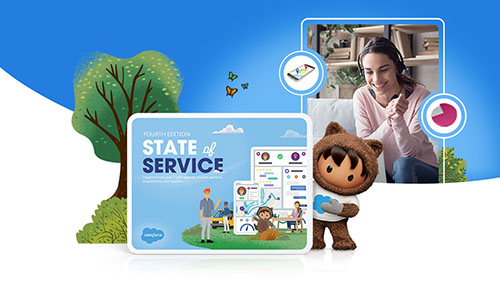


Customer service has taken center stage as companies build trust and drive loyalty today and into the future. Now, meeting customer service expectations while balancing distributed workforces and new business models means service professionals need to rewrite their approach to customer service. This includes key strategies to respond to customer needs, ways to help agents adapt to a more strategic role, and ensuring everyone stays safe.
In our earlier post, we talked about how customer service teams can deliver standout service. But you can’t keep customers happy without empowering your customer service team. Your team needs to be comfortable using new tools like chatbots and artificial intelligence (AI). They will also need support when it comes to helping customers remotely.
This post, the second in our two-part series on the state of service today, will focus on how to set your customer service team up for success. These recommendations come from over 7,000 service professionals across 33 countries for the fourth edition of the State of Service report.
Note: If you’d like to check out the State of Service findings first before diving in, read the executive summary.
Despite an increase in customer inquiries, service budgets and headcount largely remain flat or down.
To help your teams do more with less, try these tips:
Service organisations have increased adoption of chatbots by 67% since 2018. Chatbots play an important role in answering common questions, like order status or password resets. If a case requires an agent, chatbots collect customer data and share it with the agent so that they have everything they need to resolve the case.
Seventy-seven percent of agents say automating routine tasks, such as gathering basic information and customer feedback, allows them to focus on more complex work. Use automation to scale support, close cases faster, and classify cases. With automation, you can also route cases to the next available agent with the right skillset. Finally, automation powers chatbots to collect information and resolve routine issues.
“77% of agents say automating routine tasks, such as gathering basic information and customer feedback, allows them to focus on more complex work.”
Artificial intelligence (AI) analyses data and works behind the scenes to trigger actions. So, if a customer reaches out with a question on how to change a shipping address, AI can prompt next steps for the agent. (Learn more about how to apply AI to your customer service.)
Many agents are optimistic about what the future holds. Sixty-seven percent see a clear career path — up from 59% in 2018.
Here’s what you can do to empower your team:
In addition to their central role in keeping customers happy, the trend of service teams functioning as new and valuable sales channels puts them in increasingly high esteem. Use digital training tools like MyTrailhead to teach cross-sell and upsell techniques.
On the flip side, train employees impacted by temporary store closures or layoffs to work in service and support. Sixty-two percent of service organisations say employees from other departments took on customer service roles during the pandemic.
“Service agents are optimistic about what the future holds. Sixty-seven percent see a clear career path — up from 59% in 2018.”
The majority of service professionals either expect to work remotely into 2021 or remain uncertain about their future work settings. Give your teams digital tools, like collaboration documents, to work together from anywhere in real time. Keep morale high by encouraging teams to connect on enterprise social networks or employee communities as well.
Reduce the time onsite or eliminate the need for visits altogether to keep mobile workers safe with visual remote assistance.
During the pandemic, Sports Engineering And Recreation Asia Ltd. (Seara) could not send technicians to customers’ homes. That did not stop the fitness equipment supplier from helping customers to install equipment. When a customer needed an installation but had elderly people at home, Seara assisted with the installation in the customer’s home by video.
Eighty-two percent of customers say that treatment of employees during this year’s crises influence their decision to buy from a company. Try Work.com solutions, designed to help businesses adapt to the new ways of working. Assess employee health and wellness, train employees on new safety protocols, and manage shifts to reduce potential exposure to the virus.
In cases where on-site visits are necessary, Seara uses Field Service Lightning to ensure that it sends the right parts and right technicians. This reduces the need for repeat visits.
New safety challenges, technological advancements, and changing customer expectations mean that continued training is paramount. Improving your team’s skills also helps to make them feel like you are invested in their growth.
Get started by diving into the latest findings from the Salesforce State of Service report.
Learn how Service Cloud helps you build trust and loyalty, as well as exceed customer expectations.
Another version of this article originally appeared on the U.S.-version of the Salesforce blog.